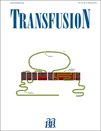Novel test for microparticles in platelet-rich plasma and platelet concentrates using dynamic light scattering
Abstract
BACKGROUND: The level and clinical importance of platelet (PLT)-derived microparticles (PMPs) in PLT-rich plasma (PRP) and PLT transfusions is largely unknown due to the lack of technology to routinely determine the number and size of PMP in PLT samples. Dynamic light scattering (DLS) is ideally suited to measure particles of submicron size but has previously been limited to the analysis of PLT-free samples.
STUDY DESIGN AND METHODS: PMPs were enumerated in 81 PRP and 79 apheresis PLT concentrate (APC) samples from the same donors using ThromboLUX (LightIntegra Technology, Inc.), a new DLS PLT quality test. The ThromboLUX results were compared with flow cytometry. Phase contrast and differential interference contrast (DIC) microscopy were used to qualitatively determine PMP levels.
RESULTS: The relative counts of PMPs measured by flow cytometry strongly correlated with the relative light scattering intensities of the PMP determined by ThromboLUX in both PRP (R = 0.7596, p < 0.0001) and APC (R = 0.6572, p < 0.0001) samples. High or low PMP levels in PLT samples were confirmed by phase contrast and DIC microscopy. The mean PMP radius measured with ThromboLUX, an absolute sizing technology, was 117.1 ± 77.6 nm as determined from the distribution of PMP content in all PLT samples investigated in this study.
CONCLUSIONS: Correlation with flow cytometry and microscopy showed that ThromboLUX is well suited to measure PMP concentration and size distribution in PLT concentrate samples. In combination with noninvasive sampling, ThromboLUX could provide routine microparticle enumeration of PLT-containing samples.




